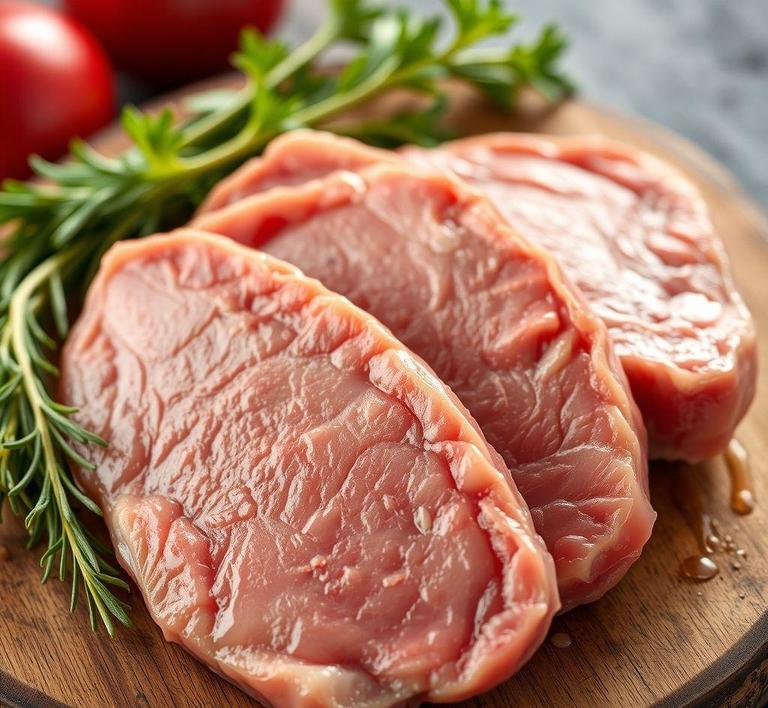If you’ve ever found yourself with leftover veal cutlets and you’re unsure whether to store them for later, you’re not alone. Refreezing veal cutlets is a convenient way to preserve their flavor and texture, but it’s important to do it the right way to avoid compromising the quality of the meat. Whether you’ve thawed them out too early or simply want to save some for another meal, knowing how to safely refreeze veal cutlets can help maintain their tenderness and juiciness. In this guide, we’ll walk you through the best practices for refreezing veal cutlets so you can enjoy them at their best, even after they’ve been frozen and thawed.
Can You Refreeze Veal Cutlets?

Yes, you can refreeze veal cutlets-but with important caveats. The safety and quality of refreezing largely depend on how the meat was handled during the initial thaw. If the veal was thawed properly in the refrigerator and has remained cold (at or below 40°F or 4°C), it is generally safe to refreeze it. However, if the cutlets were thawed at room temperature, in a microwave, or in cold water and have reached temperatures above 40°F for an extended period (over two hours), refreezing becomes a risky proposition. In such cases, bacteria may have started to multiply, and freezing won’t kill them-it simply halts their activity.
It’s essential to understand the USDA’s guidance here: refreezing meat is permissible, but repeated cycles of thawing and freezing should be minimized. Not only for food safety but for texture and taste reasons as well.
How To Refreeze Veal Cutlets?
Refreezing veal cutlets the right way involves a combination of proper timing, clean handling, and correct packaging to lock in as much freshness as possible. Here’s a step-by-step guide:
-
✅ Ensure Proper Thawing
- Only refreeze veal that has been thawed in the refrigerator. It should not have been left out on a countertop or exposed to warm environments.
- The cutlets should still feel cold to the touch. If there is any sign of sliminess or an off-odor, discard rather than refreeze.
-
🧼 Handle With Clean Utensils
- Before repackaging, make sure your hands, cutting boards, and any utensils used are sanitized to avoid cross-contamination.
- Pat the veal dry with paper towels to reduce surface moisture, which can lead to freezer burn.
-
🧊 Package Properly
- Wrap each cutlet individually in plastic wrap or butcher paper.
- Then, place the individually wrapped pieces in a heavy-duty freezer-safe bag or airtight container. Removing as much air as possible prevents ice crystals and helps preserve the texture.
- Label each package with the date of refreezing. Refrozen veal cutlets are best used within 2 to 3 months for optimal quality.
-
🌡️ Freeze Quickly
- Place the veal cutlets in the coldest part of your freezer. Rapid freezing helps minimize the size of ice crystals that form within the meat, which can rupture muscle fibers and degrade texture.
Quality Impact
While it is safe to refreeze veal cutlets under the right conditions, it’s important to set expectations: the quality will likely be affected. Each freeze-thaw cycle affects the structure of the meat. As water within the veal cells freezes and expands, it can cause cellular damage. When the meat is thawed again, some of this internal moisture is lost, leaving the cutlets drier and slightly tougher.
The more delicate the cut of veal, the more pronounced this textural change will be. Thinly sliced or pounded cutlets are especially susceptible. The flavor might also take a hit, especially if the cutlets weren’t wrapped tightly and absorbed odors from other foods in the freezer.
Refreezing marinated veal cutlets adds another layer of complexity: certain marinades can break down protein structures further, and the freezing process can intensify this breakdown, resulting in an unpleasantly mushy texture.
Refreezing veal cutlets is a practice that should be approached with care, but it is entirely feasible when done correctly. The keys lie in proper initial thawing, rapid and airtight packaging, and minimizing the number of freeze-thaw cycles. From a safety perspective, refrigerator-thawed veal can be refrozen without issue. From a culinary standpoint, however, be prepared for some degradation in texture and juiciness.
In a perfect world, you’d portion veal cutlets before freezing to avoid the need for refreezing. But when real-life circumstances require a second trip to the freezer, knowledge and precision can help you maintain both safety and flavor integrity. For best results, use refrozen veal cutlets in recipes where they’ll be cooked in moisture-like braises or stews-to offset any loss in tenderness.
Is It Safe To Refreeze Veal Cutlets?
Refreezing veal cutlets, like any meat, is a matter of both science and sensibility. From a strictly food safety perspective, veal cutlets can be refrozen-provided they were thawed correctly. This means the cutlets must have been thawed in the refrigerator, where the temperature remains below 40°F (4°C), and not left out on a countertop or in warm water.
Refreezing is safe under these refrigerated conditions because harmful bacteria do not have the opportunity to multiply rapidly at such low temperatures. However, the quality of the veal may deteriorate upon refreezing. Every freeze-thaw cycle causes ice crystals to form, which rupture the delicate muscle fibers of the meat. This can result in a drier, less tender texture once cooked.
Therefore, while it’s technically safe to refreeze veal cutlets under the right circumstances, doing so should be a carefully considered decision, balancing food safety with the desire for optimum taste and texture.
Signs That Veal Cutlets Should Not Be Refrozen
There are several red flags that indicate veal cutlets should not return to the freezer:
- Off-putting odor: Fresh veal has a mild, slightly sweet smell. If the cutlets emit a sour, ammonia-like, or otherwise unpleasant odor, spoilage has likely begun, and refreezing is not only unwise but dangerous.
- Discoloration: A change from pinkish-red to a dull grey or brown may signal oxidation or microbial activity. While color alone isn’t a definitive sign of spoilage, it should prompt closer inspection.
- Slimy or tacky texture: A sticky or slippery film on the surface is often a byproduct of bacterial growth. This is a critical sign that the veal is no longer safe to eat or refreeze.
- Excessive time at room temperature: If veal cutlets were left out for more than two hours (or just one hour in hot weather), they fall into the “danger zone” (40-140°F or 4-60°C), where bacteria multiply quickly. Such meat should never be refrozen or consumed.
- Ice crystals and freezer burn: If previously frozen veal has large ice crystals or dry, white patches, it may have been improperly stored or defrosted and re-frozen before. While not inherently unsafe, the quality will be compromised.
Common Refreezing Mistakes
Even well-meaning home cooks can stumble when handling veal and other meats. Here are some of the most frequent missteps:
- Thawing on the counter: Letting meat thaw at room temperature is a major food safety hazard. Bacteria can grow on the outer layers of the cutlets while the interior remains frozen, creating the perfect environment for pathogens.
- Refreezing after partial cooking: Partially cooking veal to “save it” before freezing again is not recommended. The internal temperature may not reach a level sufficient to kill bacteria, allowing them to survive and multiply when the meat is thawed again.
- Freezing for too long: Refreezing veal that has already spent extended time in the freezer (over 4-6 months) will likely yield poor results. Over time, even well-wrapped meat succumbs to freezer burn and flavor loss.
- Using improper packaging: Tossing veal cutlets back into the freezer in thin supermarket trays or plastic wrap leads to freezer burn. Always rewrap in freezer-safe, airtight packaging to preserve quality.
- Overlooking cross-contamination: Handling thawed veal and using the same tools or surfaces without proper cleaning before repackaging can transfer bacteria, increasing the risk of foodborne illness.
Tips And Tricks
To safely and smartly manage refreezing veal cutlets, keep these tips in mind:
- Portion Control: When initially freezing veal, divide it into meal-sized portions. This way, you only need to defrost what you’ll actually use, minimizing waste and eliminating the need to refreeze.
- Quick Labeling: Clearly mark packaging with the original freeze date and thaw date. This helps you track how long the veal has been in the fridge or freezer and avoid guesswork later.
- Vacuum Sealing: For those serious about preserving quality, vacuum sealing veal cutlets can dramatically reduce freezer burn and maintain flavor integrity.
- Flash Freeze Before Storing: Place individual cutlets on a baking sheet in the freezer for a few hours before packaging together. This helps prevent them from sticking and allows for easier portioning later.
- Use within 24-48 Hours of Thawing: If veal cutlets have been thawed in the refrigerator, aim to cook or refreeze them within two days to stay within the USDA’s safe window.
- When in Doubt, Cook First: If you suspect veal has been thawed a bit too long but still appears safe, consider cooking it fully and then freezing the cooked product. This halts any bacterial activity and gives the cutlets a second life in stews, pastas, or sandwiches.
Conclusion
Refreezing veal cutlets isn’t inherently dangerous, but it walks a fine line between practicality and prudence. The key lies in strict adherence to food safety guidelines-thawing in the refrigerator, recognizing signs of spoilage, and ensuring the meat hasn’t lingered too long at unsafe temperatures. While refreezing may cause some loss in texture and moisture, these effects can be minimized with smart handling, proper packaging, and timely action.
In essence, the freezer is a powerful ally in the kitchen-but only when used with care and clarity. Know your veal, trust your senses, and when in doubt, cook it out. A little knowledge goes a long way in protecting both your palate and your health.


